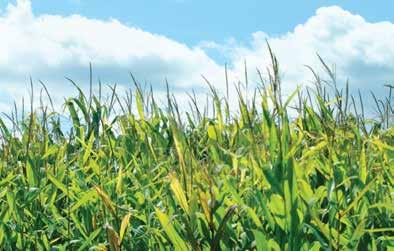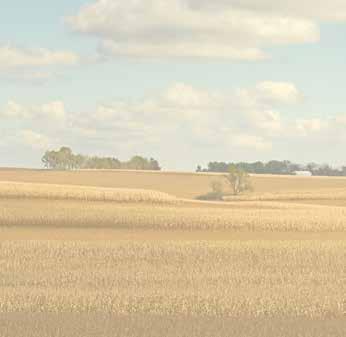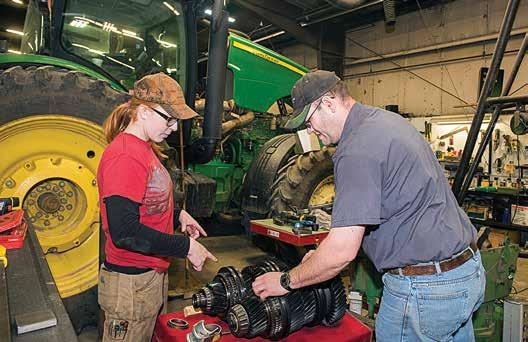
5 minute read
Another wet spring on the horizon?
by Shaw Media
Shaw Media file photo Some farmers in North Central Illinois didn’t catch a break with the weather last year until June, and they had to be quick to take advantage of a rare few days of uninterrupted sunshine to do tillage and planting. Unfortunately, some fields were left unplanted, and many that were planted included areas where work wasn’t possible because of wet spots.
Stressful planting seasons could become routine, hurting Illinois farmers and the economy
By Ben Orner Capito l News Illino is
SPRINGFIELD — The state’s climatologist is predicting Illinois farmers are likely to endure more burdensomely wet weather while they try to plant cash crops this spring after suffering major losses as a result of a record-wet planting season last year.
April through June is likely to be wetter than normal in Illinois, according to rainfall projections from the National Oceanic and Atmospheric Administration, posing a challenge to corn and soybean farmers in the heart of planting season.
Right now those farmers are calculating their losses after suffering through the wettest January to June in state history last year.
Wettest of those months was May, which pushed planting of Illinois’ top two crops into June and July, when in an ideal year they’re in the ground in April.
The result: Corn and soybean production dropped 18 percent and 20 percent, respectively, according to final yield numbers from the U.S. Department of Agriculture.
Continued on page 15
Cambridge: 800-808-1812 Manlius: 800-624-5593

Your Locally Owned Petroleum Retailer WE OFFER: Premium Diesel, Gasoline, Aviation Fuel, Propane, Chevron Lubricants, Tanks, Pumps, Service
We are dedicated to helping our customers achieve maximum success. When you meet and work with a member of the Nutrien Ag Solutions Team, we are confident you will see our strengths first-hand and “Profit from our experience.”




“Farmers should expect to deal with an increased frequency of wet winters and springs,” said Illinois’ State Climatologist Dr. Trent Ford, who expects wetter-than-normal conditions to become routine.
Ford said all but far northwestern Illinois had above-average January precipitation. NOAA also projects a wetter-than-average February and March. “The last couple of decades especially we’ve seen our winters be wetter than previous decades,” Ford said. “That doesn’t mean more snow necessarily, it just means overall more precipitation.” For example, he said 20 of the past 25 winters in Peoria have been wetter than the city’s 120-plus-year average.
“Preparing for wetter-than-normal conditions to be more common or happen more frequently is something that farmers should be doing in Illinois,” Ford said.
Harm to farmers and crops
Continuous wet planting seasons present a challenge to farmers, as late planting pushes back their entire farm timeline.
State Rep. Charlie Meier, R-Okawville, grows 1,600 acres of corn and soybeans on his farm east of St. Louis.
“Our planters started rolling on June 8, and it was not pretty,” he said.
Delayed planting causes delayed harvest, which can lower end-of-year yields like farmers saw in 2019. Late harvests also leave farmers less time for tilling fields before it gets too cold, which breaks up compacted soil and deep field ruts that can hold too much water.
Unfortunately for Meier, a lot of his tillage this fall “just did not happen.”
“Those factors will all go into next year’s crop,” he said.
Now in winter, Meier and other Illinois farmers are focused on getting tractors and equipment ready for planting season and hope they can better prepare their fields in the spring.
“Any sort of pre-planting or field preparation gets delayed if we have a wetter-than-normal March or early April,” Ford said. Climate connection
Scientists point to climate change, also referred to as global warming, as a main contributor to increased rainfall.
As humans emit greenhouse gases such as carbon dioxide, they become trapped in the atmosphere. The more carbon in the atmosphere, the more moisture it can hold, increasing precipitation. “The connections there are pretty strong,” Ford said of wetter planting seasons and climate change.
“In wet regions such as this, there’s abundant water supply at the surface,” he explained. “So as the atmosphere can take in more water, it does.”
Scientists also expect heavy downpours to increase.
“If we get a large amount of precipitation in one single event, what that can do is inundate the soil very quickly and then cause a lot of runoff and flooding,” Ford said.
Impact on the bottom line
Decreases in crop production not only hurt farmers, but trickle down into other industries like corn elevators and trucking companies, said Mike Doherty, a senior economist at the Illinois Farm Bureau.
“Most of our ag businesses off the farm, which are a big part of the downstate ag economy, they all have lower revenues as well,” Doherty said.
A soggy spring could also spell danger for Illinois farmers vulnerable to further crop losses, he said.
“You have costs no matter how much of a crop you raise,” Meier said, including rent, equipment and supplies.
Continued on page 17
Sales • Farm Management • Market Evaluations









Matt Hermes, Designated Managing Broker Bureau County: 120 +/- acres in Bureau Township. 119 +/- acres tillable. Price Reduced! 39 +/- acres in Macon Township. 38.7 +/- acres tillable. Price Reduced! 94 +/- acres in Mineral Township. 91.7 +/- acres tillable. Price Reduced! 189 +/- acres in Gold Township. 182 +/- acres tillable. Price Reduced! 130 +/- acres in Gold Township. 126 +/- acres tillable. Price Reduced! Knox County: 309 +/- acres in Lynn Township. 308 +/- acres tillable. Price Reduced! 231 +/- acres in Cedar Township. 211 +/- acres tillable. Price Reduced! 45 +/- acres in Cedar Township. 44.2 +/- acres tillable. Price Reduced! Whiteside County: 143 +/- acres in Clyde Twp. 138 +/- acres tillable. Price Reduced! 25 +/- acres in Sterling Twp. 19 +/- acres tillable. New! 715,000 bushel grain storage setup in fantastic Sterling location!









